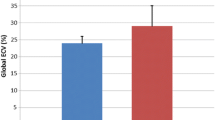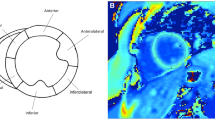Abstract
Background Progressive cardiomyopathy is a common cause of death in Duchenne muscular dystrophy (DMD), presumably secondary to fibrosis of the myocardium. The posterobasal and left lateral free wall of the left ventricle (LV) are initial sites of myocardial fibrosis pathologically. The purposes of this study were to assess whether cardiac magnetic resonance imaging (CMRI), utilizing late gadolinium enhancement (LGE), could identify fibrosis in selective areas of the myocardium, and to assess the relationship of the presence and extent of fibrosis to LV function. Methods The cardiology databases at Primary Children’s Medical Center and Cincinnati Children’s Hospital Medical Center were reviewed to identify patients with DMD who had undergone a CMRI within the last 2 years. Age, LV ejection fraction, LV mass, presence and location of LGE were documented. Volumes were measured using MASS (Medis, Inc.) to calculate ejection fraction and mass. LGE images were acquired and when positive, customized computer assisted sizing of the areas of late gadolinium enhancement were performed on all slices. Normal function was defined as LV ejection fraction >54%. Results A total of 74 patients with DMD had complete data sets (median age 13.7 years, range 7.7–26.4). Twenty-four patients (32%) had LGE involving the posterobasal region of the LV in a sub-epicardial distribution. Those patients with more involvement had spread to the inferior and left lateral free wall with progressive transmural fibrous replacement. There was relative sparing of the interventricular septum and right ventricle. Patients with LGE were significantly older than those without (mean age 16.4 vs 12.9 years, P < 0.001). LGE was positively associated with BSA-adjusted LV mass, LV end-diastolic volume, LV end-systolic volume, and RV end-systolic volume but inversely correlated with ejection fraction of the LV (P < 0.001) and RV (P = 0.004). Conclusions LGE by CMRI is able to detect fibrosis in selective regions of myocardium in patients with DMD. Unfavorable LV remodeling, with a corresponding decreased ejection fraction, is associated with the presence of LGE. Serial studies are warranted to determine if LGE precedes a decrease in function, and if early medical management is useful in preventing progression once LGE is documented.



Similar content being viewed by others
References
Towbin JA (1998) The role of cytoskeletal proteins in cardiomyopathies. Curr Opin Cell Biol 10(1):131–139. doi:10.1016/S0955-0674(98)80096-3
Finsterer J, Stollberger C (2003) The heart in human dystrophinopathies. Cardiology 99(1):1–19. doi:10.1159/000068446
Eagle M et al (2002) Survival in Duchenne muscular dystrophy: improvements in life expectancy since 1967 and the impact of home nocturnal ventilation. Neuromuscul Disord 12(10):926–929. doi:10.1016/S0960-8966(02)00140-2
Frankel KA, Rosser RJ (1976) The pathology of the heart in progressive muscular dystrophy: epimyocardial fibrosis. Hum Pathol 7(4):375–386. doi:10.1016/S0046-8177(76)80053-6
Perloff JK et al (1967) The distinctive electrocardiogram of Duchenne’s progressive muscular dystrophy. An electrocardiographic-pathologic correlative study. Am J Med 42(2):179–188. doi:10.1016/0002-9343(67)90017-4
Goldberg SJ et al (1982) Serial two-dimensional echocardiography in Duchenne muscular dystrophy. Neurology 32(10):1101–1105
Silva MC et al (2007) Myocardial delayed enhancement by magnetic resonance imaging in patients with muscular dystrophy. J Am Coll Cardiol 49(18):1874–1879. doi:10.1016/j.jacc.2006.10.078
Heymsfield SB et al (1978) Sequence of cardiac changes in Duchenne muscular dystrophy. Am Heart J 95(3):283–294. doi:10.1016/0002-8703(78)90358-7
Takenaka A et al (1993) Discrepancy between systolic and diastolic dysfunction of the left ventricle in patients with Duchenne muscular dystrophy. Eur Heart J 14(5):669–676
Sasaki K et al (1998) Sequential changes in cardiac structure and function in patients with Duchenne type muscular dystrophy: a two-dimensional echocardiographic study. Am Heart J 135(6 Pt 1):937–944. doi:10.1016/S0002-8703(98)70057-2
Duboc D et al (2005) Effect of perindopril on the onset and progression of left ventricular dysfunction in Duchenne muscular dystrophy. J Am Coll Cardiol 45(6):855–857. doi:10.1016/j.jacc.2004.09.078
Lorenz CH (2000) The range of normal values of cardiovascular structures in infants, children, and adolescents measured by magnetic resonance imaging. Pediatr Cardiol 21(1):37–46. doi:10.1007/s002469910006
American Academy of Pediatrics Section on Cardiology and Cardiac Surgery (2005) Cardiovascular health supervision for individuals affected by Duchenne or Becker muscular dystrophy. Pediatrics 116(6):1569–1573. doi:10.1542/peds.2005-2448
Raman SV et al (2007) Mid-myocardial fibrosis by cardiac magnetic resonance in patients with lamin A/C cardiomyopathy: possible substrate for diastolic dysfunction. J Cardiovasc Magn Reson 9(6):907–913. doi:10.1080/10976640701693733
Perloff JK, Henze E, Schelbert HR (1984) Alterations in regional myocardial metabolism, perfusion, and wall motion in Duchenne muscular dystrophy studied by radionuclide imaging. Circulation 69(1):33–42
Aurigemma GP, Zile MR, Gaasch WH (2006) Contractile behavior of the left ventricle in diastolic heart failure: with emphasis on regional systolic function. Circulation 113(2):296–304. doi:10.1161/CIRCULATIONAHA.104.481465
Rosen BD et al (2006) Lower myocardial perfusion reserve is associated with decreased regional left ventricular function in asymptomatic participants of the multi-ethnic study of atherosclerosis. Circulation 114(4):289–297. doi:10.1161/CIRCULATIONAHA.105.588525
Kehr E et al (2008) Gadolinium-enhanced magnetic resonance imaging for detection and quantification of fibrosis in human myocardium in vitro. Int J Cardiovasc Imaging 24(1):61–68. doi:10.1007/s10554-007-9223-y
Nigro G et al (1990) The incidence and evolution of cardiomyopathy in Duchenne muscular dystrophy. Int J Cardiol 26(3):271–277. doi:10.1016/0167-5273(90)90082-G
Corrado G et al (2002) Prognostic value of electrocardiograms, ventricular late potentials, ventricular arrhythmias, and left ventricular systolic dysfunction in patients with Duchenne muscular dystrophy. Am J Cardiol 89(7):838–841. doi:10.1016/S0002-9149(02)02195-1
de Kermadec JM et al (1994) Prevalence of left ventricular systolic dysfunction in Duchenne muscular dystrophy: an echocardiographic study. Am Heart J 127(3):618–623. doi:10.1016/0002-8703(94)90672-6
Lanza GA et al (2001) Impairment of cardiac autonomic function in patients with Duchenne muscular dystrophy: relationship to myocardial and respiratory function. Am Heart J 141(5):808–812. doi:10.1067/mhj.2001.114804
Melacini P et al (1996) Cardiac and respiratory involvement in advanced stage Duchenne muscular dystrophy. Neuromuscul Disord 6(5):367–376. doi:10.1016/0960-8966(96)00357-4
Backman E, Nylander E (1992) The heart in Duchenne muscular dystrophy: a non-invasive longitudinal study. Eur Heart J 13(9):1239–1244
Author information
Authors and Affiliations
Corresponding author
Rights and permissions
About this article
Cite this article
Puchalski, M.D., Williams, R.V., Askovich, B. et al. Late gadolinium enhancement: precursor to cardiomyopathy in Duchenne muscular dystrophy?. Int J Cardiovasc Imaging 25, 57–63 (2009). https://doi.org/10.1007/s10554-008-9352-y
Received:
Accepted:
Published:
Issue Date:
DOI: https://doi.org/10.1007/s10554-008-9352-y




